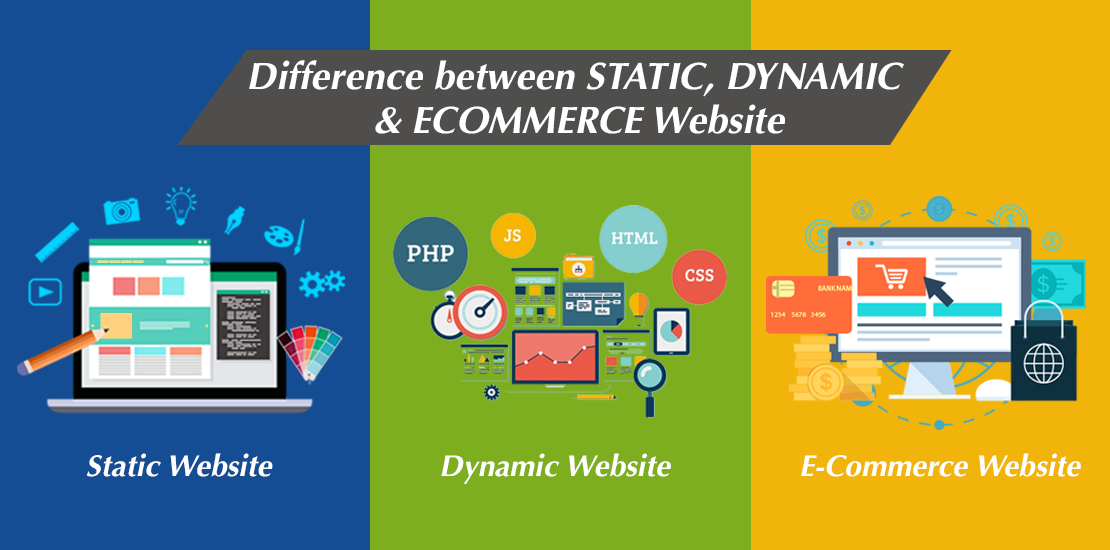In the world of web development, websites can be broadly categorized into three main types: static, dynamic, and eCommerce. Each type serves different purposes, caters to distinct needs, and employs various technologies. Understanding the characteristics, advantages, and disadvantages of each type is important for making informed decisions when planning a website.
What do you understand by Static Website?
A static website is a type of website that contains fixed content and displays the same information to all users. This means the content of a static website does not change based on user input or preferences. The web pages of a static website are written in HTML and CSS, and they are stored as static files on the server. Since the content is fixed, any updates or changes to the website must be made manually by editing the code or through a content management system (CMS). Static websites are simple, easy to create, cost-effective, and have faster loading times compared to dynamic websites. They are suitable for showcasing basic information, portfolios, or small businesses that do not require frequent updates or interactivity.
Important Key Characteristics of Static Websites:
Simplicity:
Static websites are uncomplicated in their structure, typically comprising HTML and CSS files. The absence of dynamic elements makes them easy to create and manage.
Fixed Content:
The content on static websites remains constant until deliberately modified by a developer. Unlike dynamic sites, there is no real-time generation of content based on user interactions.
Limited Interactivity:
Interactivity is minimal on static sites. They generally do not involve complex features like user authentication, real-time updates, or personalized content delivery.
Use Cases for Static Websites:
Small Businesses:
Static websites are an excellent choice for small businesses looking to establish a basic online presence. They provide essential information about the business, such as services offered, contact details, and location.
Personal Portfolios:
Individuals, such as artists, photographers, or writers, often use static websites to showcase their work. The simplicity of static sites allows for a clean and focused presentation of portfolio items.
Blogs with Modest Content:
Static websites are suitable for blogs with limited content requirements. Bloggers who prioritize a straightforward layout and do not need advanced features often opt for static sites.
Advantages of Static Websites:
1. Ease of Development:
Static websites are known for their simplicity, making them quick to develop. Developers with basic HTML and CSS skills can efficiently create static sites without the need for complex server-side scripting or database integration. This characteristic makes them an ideal choice for projects with straightforward content and limited interactivity requirements.
2. Cost-Effective:
Hosting static websites is generally more cost-effective than hosting dynamic ones. Since static sites do not involve server-side processing or dynamic content generation, the infrastructure requirements are minimal. This results in lower hosting costs, making static websites a budget-friendly option, particularly for projects with limited financial resources.
3. Fast Loading Speed:
Static websites load rapidly due to their efficient delivery of pre-rendered HTML files directly to the user's browser. The absence of server-side processing and dynamic content generation contributes to faster page loading times. This characteristic enhances user experience by providing quick access to information without delays, making static websites suitable for projects where fast loading speed is crucial.
4. Security:
The simplicity of static websites also contributes to enhanced security. With minimal server-side scripting and no database interaction, static sites have a reduced attack surface, making them less susceptible to certain types of security vulnerabilities. This can be advantageous for projects that prioritize a secure online presence.
5. Reliability:
Static websites are inherently reliable because the content remains fixed until manually updated. Users accessing the site experience consistent information, and there is a lower likelihood of unexpected changes or errors. This reliability is beneficial for projects that require a stable and predictable online presence.
6. Low Maintenance:
Static websites are generally easier to maintain compared to dynamic ones. Updates to the content or design can be made by directly modifying the HTML and CSS files. While this may require coding knowledge, it simplifies the maintenance process, especially for projects with infrequent updates or limited content changes.
Disadvantages of Static Websites:
1. Limited Functionality:
Static websites are characterized by their limited interactivity and lack of advanced features. They do not easily support complex functionalities such as user authentication, real-time updates, or personalized content delivery. This limitation can be a drawback for projects that require dynamic user engagement and interactive features.
2. Updates Require Coding Knowledge:
Making changes to content or design on static websites necessitates coding skills. This requirement poses a challenge for individuals or businesses without technical expertise. Unlike content management systems (CMS) that provide user-friendly interfaces for updates, static sites rely on manual coding, making it less accessible for non-technical users.
3. Scalability Challenges:
Managing large volumes of content can become cumbersome with static websites. As the website grows and more content is added, organizing and updating the content manually becomes increasingly time-consuming. This scalability challenge may hinder the effectiveness of static websites for projects with extensive content requirements or frequent updates.
4. Interactivity Constraints:
The minimal interactivity of static websites can be a limitation for projects that demand dynamic user experiences. Features like interactive forms, user-generated content, or real-time data presentation are challenging to implement on static sites. This constraint may limit the engagement level and functionality of the website.
5. Lack of Personalization:
Static websites typically provide the same content to all users, lacking the ability to personalize information based on individual preferences or behaviors. For projects where personalized content delivery is crucial for user engagement, this limitation can be a significant drawback.
6. Inefficiency for Complex Projects:
For complex projects with intricate functionalities or requirements for frequent updates, static websites may prove inefficient. Their simplicity, while advantageous for certain scenarios, becomes a limitation when dealing with projects that demand a higher degree of sophistication and dynamic content management.
Static Website Examples:
Brochure Websites:
Static websites are commonly used as digital brochures for businesses, providing essential information about products or services.
Personal Portfolios:
Individuals, such as artists, photographers, or writers, often use static websites to showcase their work in a simple and visually appealing manner.
Event Websites:
Websites for events, conferences, or exhibitions that require a static display of information such as schedules, speakers, and venue details.
What do you u understand by Dynamic Website?
A dynamic website is a type of website that generates content dynamically based on user interactions, input, or preferences. Unlike static websites, dynamic websites use databases, server-side scripting languages (such as PHP, Python, Ruby, or JavaScript), and content management systems (CMS) to create and update content on-the-fly. Dynamic websites can display personalized content for each user, incorporate interactive features like user login, forms, forums, or online shopping carts. They are more complex to develop, require regular maintenance, and have slower loading times compared to static websites. Dynamic websites are suitable for businesses or organizations that need frequent content updates, interactivity, or customization based on user behavior.
Key Characteristics of Dynamic websites:
Server-Side Processing:
Dynamic websites rely on server-side processing, allowing them to generate content in real-time. This enables a personalized and interactive user experience.
Database Integration:
Dynamic websites often utilize databases to store and retrieve information. This dynamic data retrieval contributes to the real-time and customized nature of the content.
Personalization:
Content on dynamic websites can be tailored to individual users based on their preferences, history, or interactions with the site.
Use Cases for Dynamic Websites:
Content-Heavy Platforms:
Dynamic websites excel in scenarios where there is a need for frequent content updates, such as news sites, blogs, or forums.
E-commerce Platforms:
Online stores benefit from dynamic websites as they can offer personalized product recommendations, handle real-time inventory updates, and facilitate secure transactions.
Interactive Web Applications:
Web applications that require user authentication, forms, or interactive elements, such as social media platforms, are often built as dynamic websites.
Advantages of Dynamic Websites:
1. Interactivity:
Dynamic websites excel in providing highly interactive user experiences. Unlike static websites, dynamic elements can respond to user inputs, creating a more engaging and personalized interface. This interactivity enhances user satisfaction and allows for the implementation of dynamic features that respond to user actions in real-time.
2. Easy Content Management:
Dynamic websites enable easy content management through server-side processing. Content creators can add, edit, or remove content dynamically without the need for manual coding. Content management systems (CMS) often accompany dynamic websites, providing user-friendly interfaces that simplify the process of updating and maintaining content.
3. Scalability:
Dynamic websites efficiently handle large volumes of content, making them scalable as the site grows. The use of databases allows for organized storage and retrieval of data, streamlining content management. This scalability is crucial for projects with extensive content requirements, ensuring a smooth and organized handling of information as the website expands.
4. Enhanced Functionality:
Dynamic websites support advanced features that enhance functionality and user engagement. Features such as user authentication, interactive forms, and forums are feasible on dynamic platforms. The versatility of dynamic websites enables the implementation of diverse functionalities, catering to the specific needs of the project.
5. Real-Time Updates:
Dynamic websites can provide real-time updates to users, ensuring that the content is always current and relevant. This real-time aspect is particularly beneficial for websites that require frequent updates, such as news portals, blogs, or social media platforms.
6. Personalization:
Dynamic websites have the capability to personalize content based on user preferences, history, or interactions with the site. This personalization enhances the user experience by delivering tailored content, recommendations, or features, contributing to increased user engagement and satisfaction.
7. Integration with Databases:
Dynamic websites often integrate with databases, allowing for the storage and retrieval of complex data structures. This integration enhances the website's capabilities by supporting features such as user accounts, product catalogs, and dynamic content generation based on database queries.
Disadvantages of Dynamic Websites:
1. Complex Development:
Developing dynamic websites involves more advanced programming skills compared to static websites. The complexity arises from the need for server-side scripting, database management, and other intricate processes. This complexity can pose a challenge for individuals or businesses without the technical expertise required for dynamic web development.
2. Higher Cost:
The hosting and development costs associated with dynamic websites are generally higher than those of static websites. The infrastructure required to support server-side processing, database management, and other dynamic elements contributes to increased expenses. This higher cost can be a significant consideration, particularly for projects with budget constraints.
3. Slower Loading Speed:
Dynamic websites may experience slower loading times compared to static sites. The inclusion of server-side processing and database queries can contribute to increased latency in content delivery. While advancements in technology and optimization techniques aim to mitigate this issue, achieving the same level of speed as static sites can be challenging for dynamic websites.
4. Maintenance Challenges:
Dynamic websites can be more challenging to maintain compared to static sites. The complexity of the codebase, frequent updates, and the need for ongoing database management can make maintenance tasks more intricate. This can result in increased time and effort required for system updates, security patches, and overall website upkeep.
5. Security Concerns:
Dynamic websites are susceptible to security threats, especially with the inclusion of server-side scripting and databases. The complexity of the development process can introduce potential vulnerabilities that may be exploited by malicious entities. Robust security measures are essential to safeguard sensitive data and protect against potential security breaches.
6. Dependency on Server-Side Processing:
Dynamic websites heavily rely on server-side processing to generate content dynamically. This dependency makes them more susceptible to server-related issues, including server downtimes or overloads. In scenarios where server responsiveness is critical, such as high-traffic periods, the reliance on server-side processing can become a potential drawback.
Dynamic Website Examples:
Content Management Systems (CMS): WordPress, Joomla, and Drupal are dynamic platforms.
Social Media Platforms: Facebook, Twitter, and LinkedIn utilize dynamic website structures.
E-learning Platforms: Websites with interactive courses and quizzes.
What do you understand by an eCommerce Website?
An eCommerce website is an online platform that allows businesses to sell products or services over the internet. These websites typically include features such as product listings, shopping carts, payment gateways, and order tracking systems to facilitate online transactions. eCommerce sites may be either static or dynamic, depending on the complexity of their functionalities and personalization options. They provide a convenient way for customers to browse, compare, and purchase items from the comfort of their own homes, making them essential for businesses looking to expand their reach and increase sales in the digital marketplace.
Key Characteristics of an eCommerce Website:
Online Transactions:
eCommerce websites facilitate buying and selling transactions over the internet. They provide a platform for customers to browse products, make purchase decisions, and complete transactions online.
Dynamic Elements:
Dynamic features such as shopping carts, product catalogs, and secure payment gateways are integral to eCommerce websites. These elements allow for a seamless and secure online shopping experience.
Global Reach:
eCommerce enables businesses to extend their reach globally, breaking down geographical barriers. Customers from different parts of the world can access and purchase products or services.
Use Cases for ecommerce Websites:
Online Retail Stores:
eCommerce websites are widely used by traditional retailers to extend their reach and sell products online. These can range from clothing and electronics to books and household goods.
Marketplaces:
eCommerce marketplaces bring together multiple sellers and buyers on a single platform. Examples include Amazon, eBay, or Etsy, where various vendors can list and sell their products.
Subscription-Based Services:
Businesses offering subscription-based services, such as streaming platforms, subscription boxes, or online magazines, use eCommerce websites to manage recurring payments and provide access to premium content.
Advantages of eCommerce Websites:
1. Global Reach:
One of the significant advantages of eCommerce is its ability to transcend geographical boundaries. Businesses can reach a worldwide audience, breaking down traditional limitations imposed by physical locations. This global reach expands the potential customer base, allowing businesses to tap into markets beyond their local areas.
2. 24/7 Accessibility:
eCommerce websites operate round the clock, providing customers with the flexibility to shop at any time. The 24/7 accessibility accommodates diverse time zones, allowing businesses to cater to customers across different regions and maximize potential sales. This continuous availability is a key advantage over brick-and-mortar stores with fixed operating hours.
3. Inventory Management:
eCommerce platforms often come equipped with automatic inventory tracking systems. This feature helps businesses efficiently manage stock levels, update product availability, and avoid over-selling or under-selling. Real-time inventory tracking ensures accurate product information for customers and streamlines the logistics and fulfillment processes for the business.
4. Data Insights:
eCommerce websites generate valuable data on customer behavior, preferences, and purchasing patterns. Analytics tools integrated into eCommerce platforms provide insights into user interactions, popular products, and conversion rates. This data can be leveraged for informed decision-making, marketing strategies, product improvements, and personalized customer experiences.
5. Expanded Market Opportunities:
eCommerce opens up opportunities for businesses to explore new markets and target diverse customer segments. Whether operating in niche markets or catering to a broad audience, eCommerce platforms provide the flexibility to adapt and expand as business needs evolve.
6. Cost-Efficiency:
Operating an eCommerce business can be more cost-efficient than maintaining a physical storefront. Reduced expenses related to brick-and-mortar overhead, such as rent, utilities, and staffing, contribute to cost savings. This allows businesses to allocate resources strategically, investing in areas such as digital marketing, technology, and product quality.
7. Convenience for Customers:
eCommerce offers convenience for customers by eliminating the need to travel to physical stores. Online shopping provides a seamless and user-friendly experience, allowing customers to browse products, compare prices, and make purchases from the comfort of their homes or on the go.
Disadvantages of eCommerce Websites:
1. Complex Development:
Building a robust and secure eCommerce website demands advanced development skills. The complexity arises from the implementation of features such as secure payment gateways, inventory management, order processing, and integration with third-party systems. Achieving a seamless and user-friendly eCommerce platform requires technical expertise, making development more intricate compared to other types of websites.
2. Costs:
The costs associated with eCommerce websites can be substantial. Development, hosting, and maintenance expenses contribute to the overall financial investment required. The infrastructure necessary to support online transactions, ensure the security of customer data, and handle large volumes of traffic adds to the complexity and expense of operating an eCommerce business.
3. Security Concerns:
eCommerce sites are susceptible to security threats, including data breaches and fraudulent activities. The handling of sensitive customer information, such as personal details and payment data, makes eCommerce platforms attractive targets for cyberattacks. Robust protection measures, including encryption, secure payment gateways, and regular security audits, are essential to safeguard customer information and maintain trust.
4. Competition:
The online marketplace is highly competitive, with numerous eCommerce websites vying for the attention of consumers. Standing out in a crowded digital landscape requires effective marketing strategies, a compelling user experience, and continuous efforts to enhance product offerings. Failure to stay competitive can impact a business's success in the eCommerce space.
5. Dependence on Internet Connectivity:
eCommerce operations depend heavily on internet connectivity. Downtime, slow loading speeds, or technical issues can negatively impact the user experience and result in lost sales. Businesses must invest in reliable hosting solutions and technical infrastructure to minimize disruptions.
6. Regulatory Compliance:
eCommerce businesses must adhere to various regulatory requirements related to online transactions, data protection, and consumer rights. Staying compliant with evolving regulations adds an additional layer of complexity and may require ongoing adjustments to business practices and systems.
7. Customer Trust:
Establishing and maintaining customer trust is critical for eCommerce success. Concerns related to data security, privacy, and the reliability of online transactions can influence customer trust. Building a positive reputation and addressing customer concerns are ongoing challenges for eCommerce businesses.
eCommerce Website Examples:
Amazon:
A global eCommerce giant offering a vast range of products, from books to electronics, and providing a comprehensive online shopping experience.
Shopify:
A popular eCommerce platform that caters to businesses of all sizes, providing tools for setting up online stores, managing inventory, and processing payments.
Etsy:
A specialized eCommerce platform focusing on handmade or unique products. Etsy provides a marketplace for independent sellers and artisans to showcase their creations.
Which is Better? Static Website or Dynamic Website or eCommerce Website?
The better between a static website, dynamic website, or eCommerce website depends on the specific requirements and resources of the business. Static websites are ideal for small businesses with simple requirements, dynamic websites are ideal for larger businesses with complex requirements, and eCommerce websites are ideal for online businesses that want to sell products and services online. It's essential to choose the right type of website based on the specific needs of the business to ensure a successful online presence.
1. Static Website:
• Static websites have a fixed layout with predefined content. They are ideal for small businesses with simple requirements like showcasing products, services, or information.
• Since static websites have fixed content, they require less maintenance compared to dynamic websites. Updates and changes can be made manually or using a content management system (CMS).
• Static websites load faster because they don't rely on databases or server-side scripts to generate content. This makes them more user-friendly and SEO-friendly.
• Static websites are less expensive than dynamic websites because they require less development time and resources since they have less functionality compared to dynamic websites or eCommerce websites.
2) Dynamic Website:
• Dynamic websites have dynamic content that changes based on user input or preferences like login pages or personalized content based on user history or preferences using cookies or session variables stored on servers or databases or APIs (Application Programming Interfaces).
• Dynamic websites offer more functionality than static websites because they rely on databases or server scripts like PHP or Python or Ruby or JavaScript to generate content. This makes them ideal for larger businesses with complex requirements like online communities, forums, or social networks.
• Dynamic websites require more maintenance compared to static websites because they have more functionality and complexity that requires regular updates and security patches. This can be time consuming and expensive for small businesses with limited resources.
• Dynamic websites may have slower loading times compared to static websites because they rely on databases or server scripts to generate content. This can negatively impact user experience and SEO.
3) eCommerce Website:
• eCommerce websites offer advanced functionality like product catalogs, shopping carts, payment gateways, and order management systems that are essential for online businesses to sell products and services online.
• eCommerce websites have more complex design requirements compared to static or dynamic websites because they need to integrate multiple functionalities and features that require more development time and resources.
• eCommerce websites require more maintenance compared to static or dynamic websites because they have more functionalities and complexities that require regular updates and security patches. This can be time consuming and expensive for small businesses with limited resources.
• eCommerce websites can have slower loading times compared to static websites because they rely on databases or server scripts to generate content. However, modern eCommerce platforms like Shopify, WooCommerce, or Magento offer advanced caching and optimization techniques to improve loading times and user experience.
Conclusion:
Understanding the difference between static, dynamic, and e-commerce websites is important for making informed decisions when choosing a website creation service. Static websites are suitable for simple online presence, dynamic websites offer interactivity and frequent content updates, while e-commerce websites cater specifically to online transactions.
Clients engaging with Foduu.com can benefit from their wealth of experience, comprehensive packages, and enticing offers. Whether seeking a straightforward online presence or a feature-rich e-commerce platform, Foduu.com appears well-equipped to guide and deliver tailored solutions. In the fast growing of website development, Foduu.com stands as a reliable partner, bridging the gap between client visions and the creation of functional, visually appealing websites.




